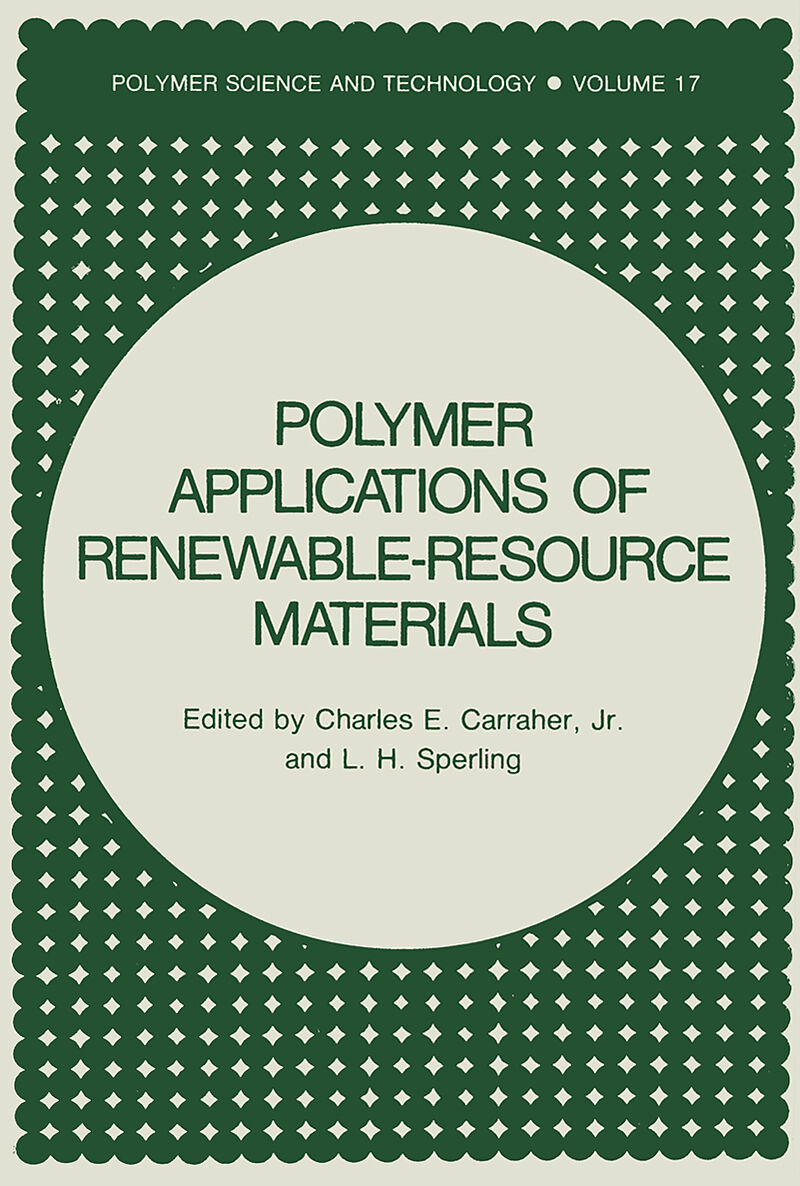Polymer Applications of Renewable-Resource Materials
Einband:
Kartonierter Einband
EAN:
9781461335054
Untertitel:
Polymer Science and Technology Series 17
Autor:
L. H. Sperling, Charles E. Carraher Jr.
Herausgeber:
Springer US
Auflage:
Softcover reprint of the original 1st ed. 1983
Anzahl Seiten:
488
Erscheinungsdatum:
17.02.2013
ISBN:
1461335051
For there is hope of a tree, If it be cut down, That it will sprout again And that the tender branch Thereof will not cease. Job XIV (7) Mankind has been blessed with a multitude of resources. In the beginning he utilized almost soley replenishable items such as vegetation and animal protein, for both nourishment and shelter. Gradually, such metals as copper and iron were developed and replaced wood as a material of construction. Cement and glass, although more plentiful than other minerals, also replaced the use of growing sub stances. Coal and oil became the primary sources of heat and power. Closer to the focus of this book, petroleum products began to replace the vegetable oils, tannin, wool, cotton, leather, silk, rubber, etc. in a host of applications. Surely, it was argued, the new materials did the job better and cheaper. What they didn't say is that soon we would run out of oil. In any case, research on growing natural products, now called renewable resources, slowed, and these industries sought only to maintain their status quo. The 20th Century saw an unprecedented emphasis and dependence on nonrenewable resources as energy sources (petroleum, coal, ura nium) and the fabric of technology (drugs, clothing, shelter, tires, computer parts). The predawn of the 21st Century brings a reali zation that a cyclic shift back towards the use of renewable re sources for technological application is in order.
Autorentext
L. H. SPERLING is Professor of Chemical Engineering and Materials Science and Engineering, and Director of the Polymer Laboratory at Lehigh University in Bethlehem, Pennsylvania.
Inhalt
Section One: Introduction.- Renewable Resource Monomers and Polymers.- Renewable Resources for Industrial Application: An Historical Perspective.- Section Two: Saccharides and Polysaccharides.- Enhancing the Use of Cellulose by Solutions in DMSO and DMAc.- Modification of Dextran Through Reaction with Organostannane Halides as a Function of Reaction System - A Model for Polysaccharide Modification.- Starch-g-Poly(Methyl Acrylate)?Effects of Graft Level and Molecular Weight on Tensile Strength.- Bagasse-Rubber Composite Technology.- Chemistry and Technology of In-Situ Generated Resin Bonded Bagasse Composite Materials.- Structural Identification of the Condensation Product of Sucrose with Organostannane.- Section Three: Wood Products.- Modified Lignan Polymers from the Resin of Parana Pine Tree Knots.- Renewable Resources from Forest Products for High Temperature Resistant Polymers.- Lignocellulose-Polymer Composites II.- Fast Curing Copolymer Resins of Phenol, Formaldehyde, and Chemicals from Forest and Agricultural Residues.- Organic Fillers for Thermoplastics.- Crystallization of Gutta Percha Networks and Associated Elasticity.- Section Four: Oils and Lacquers.- Japanese Lacquer-A Super Durable Coating (Proposed Structure and Expanded Application).- Simultaneous Interpenetrating Networks from Epoxidized Triglyceride Oils: Morphology and Mechanical Behavior.- Vernonia Oil Characterization and Polymerization, and Simultaneous Interpenetrating Polymer Networks Based on Vernonia Oil-Sebacic Acid/Polystyrene-DVB Compositions.- Monomer Reactivity Ratios of Tung Oil and Styrene in Copolymerization.- Processing Emulsified Oils and Alkyds to Generate Polymers.- Section Five: Proteinaceous Material.- Novel UV and Radiation Polymerisation Methods for Modifying Polyolefins,Cellulose and Leather.- Syntheses and Properties of Chemically Modified Poly(y-Methyl-L-Glutamate) Membranes.- Modified Fibers from Regenerated Collagen.- Relation Between the Structure of Wool Graft Copolymers and Their Dynamical Mechanical Properties.- Polymer-Leather Composites V. Preparative Methods, Kinetics, Morphology, and Mechanical Properties of Selected Acrylate Polymer-Leather Composite Materials.- Effect of Chain Transfer Agents During Graft Polymerization in Leathers.- Contributors.

Leider konnten wir für diesen Artikel keine Preise ermitteln ...
billigbuch.ch sucht jetzt für Sie die besten Angebote ...
Die aktuellen Verkaufspreise von 6 Onlineshops werden in Realtime abgefragt.
Sie können das gewünschte Produkt anschliessend direkt beim Anbieter Ihrer Wahl bestellen.
Loading...
Die aktuellen Verkaufspreise von 6 Onlineshops werden in Realtime abgefragt.
Sie können das gewünschte Produkt anschliessend direkt beim Anbieter Ihrer Wahl bestellen.
| # | Onlineshop | Preis CHF | Versand CHF | Total CHF | ||
|---|---|---|---|---|---|---|
| 1 | Seller | 0.00 | 0.00 | 0.00 |
